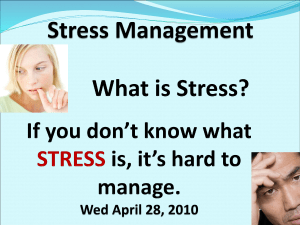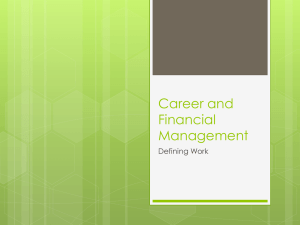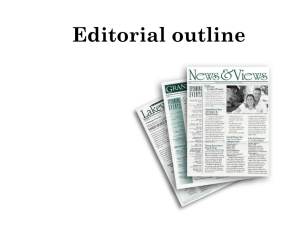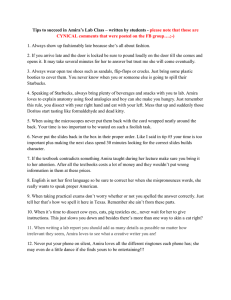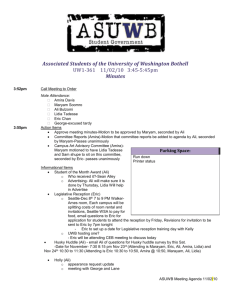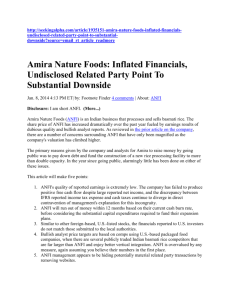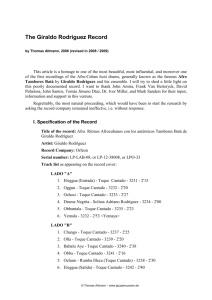Texas Essential Knowledge and Skills (TEKS) for Career Orientation,
advertisement
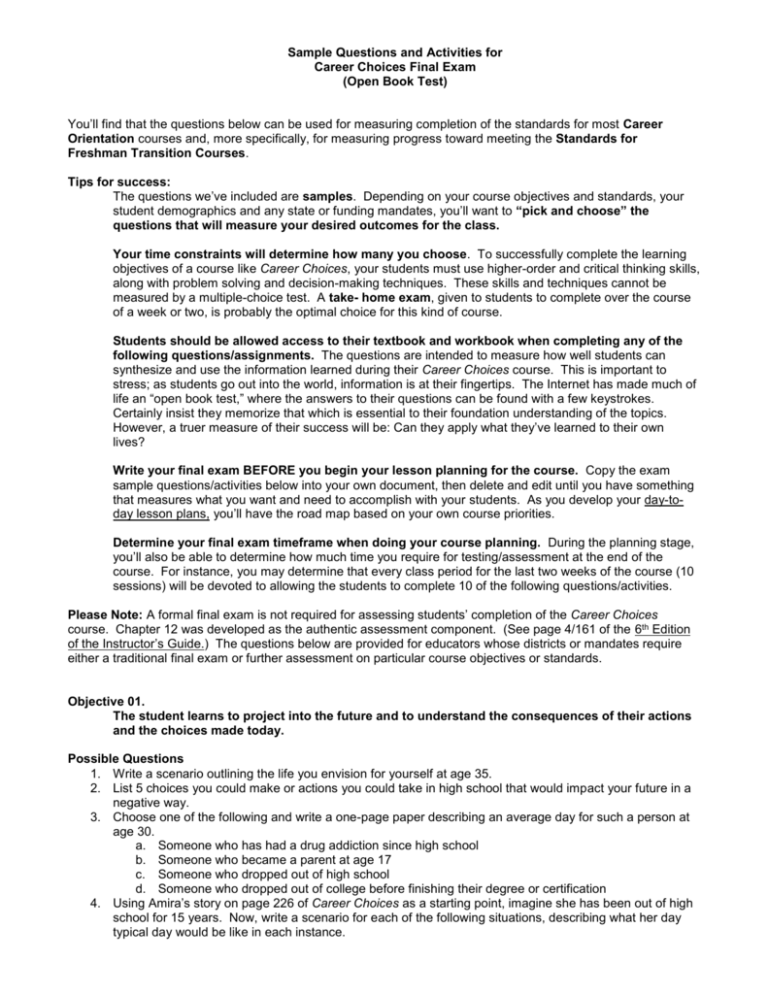
Sample Questions and Activities for Career Choices Final Exam (Open Book Test) You’ll find that the questions below can be used for measuring completion of the standards for most Career Orientation courses and, more specifically, for measuring progress toward meeting the Standards for Freshman Transition Courses. Tips for success: The questions we’ve included are samples. Depending on your course objectives and standards, your student demographics and any state or funding mandates, you’ll want to “pick and choose” the questions that will measure your desired outcomes for the class. Your time constraints will determine how many you choose. To successfully complete the learning objectives of a course like Career Choices, your students must use higher-order and critical thinking skills, along with problem solving and decision-making techniques. These skills and techniques cannot be measured by a multiple-choice test. A take- home exam, given to students to complete over the course of a week or two, is probably the optimal choice for this kind of course. Students should be allowed access to their textbook and workbook when completing any of the following questions/assignments. The questions are intended to measure how well students can synthesize and use the information learned during their Career Choices course. This is important to stress; as students go out into the world, information is at their fingertips. The Internet has made much of life an “open book test,” where the answers to their questions can be found with a few keystrokes. Certainly insist they memorize that which is essential to their foundation understanding of the topics. However, a truer measure of their success will be: Can they apply what they’ve learned to their own lives? Write your final exam BEFORE you begin your lesson planning for the course. Copy the exam sample questions/activities below into your own document, then delete and edit until you have something that measures what you want and need to accomplish with your students. As you develop your day-today lesson plans, you’ll have the road map based on your own course priorities. Determine your final exam timeframe when doing your course planning. During the planning stage, you’ll also be able to determine how much time you require for testing/assessment at the end of the course. For instance, you may determine that every class period for the last two weeks of the course (10 sessions) will be devoted to allowing the students to complete 10 of the following questions/activities. Please Note: A formal final exam is not required for assessing students’ completion of the Career Choices course. Chapter 12 was developed as the authentic assessment component. (See page 4/161 of the 6th Edition of the Instructor’s Guide.) The questions below are provided for educators whose districts or mandates require either a traditional final exam or further assessment on particular course objectives or standards. Objective 01. The student learns to project into the future and to understand the consequences of their actions and the choices made today. Possible Questions 1. Write a scenario outlining the life you envision for yourself at age 35. 2. List 5 choices you could make or actions you could take in high school that would impact your future in a negative way. 3. Choose one of the following and write a one-page paper describing an average day for such a person at age 30. a. Someone who has had a drug addiction since high school b. Someone who became a parent at age 17 c. Someone who dropped out of high school d. Someone who dropped out of college before finishing their degree or certification 4. Using Amira’s story on page 226 of Career Choices as a starting point, imagine she has been out of high school for 15 years. Now, write a scenario for each of the following situations, describing what her day typical day would be like in each instance. a. Amira is a high school dropout. b. Amira is a high school graduate who entered the workplace with no additional training or education. c. Amira attended community college and obtained an industry certification. d. Amira is a college graduate. e. Amira obtained a graduate degree or professional school certification. 5. Develop a budget for a single parent of two children whose wage is below the average in your community. Use the budget outline found on page 93. 6. Using the method learned for writing goals and objectives, develop a short-term and long-term plan for personal wellness. Address not only health issues, but also appearance and peak performance issues. Objective 02. The adolescent completes formal assessments and surveys to help them establish and consolidate their identity, becoming “identity-achieved.” Possible Questions 1. List your own unique traits, skills and aptitudes (e.g., passions, values and priorities, personality, strengths and weaknesses). 2. Write your personal definition(s) of success. 3. Identify any limiting factors that might impede your quest for a successful life. Using the problem-solving model discussed in chapter 8, develop a plan to circumvent limitations. Write a one-page paper outlining your plan. 4. Identify an anxiety or fear that you have about your future. Using the model discussed in chapter 10, develop a plan for overcoming that anxiety. Write a one-page paper outlining your plan. Objective 03. The student analyzes the effect of personal interest and aptitudes upon educational and career planning. Possible Questions 1. Using the data you discovered about yourself in Chapters 2, 3, 4 and 5, write a paper entitled “Who I Am and What I Want.” 2. Using your completed Bulls Eye Chart (found on page 27), make a list of at least 10 careers that match your interests and aptitudes. 3. Choose three of the careers you listed above and conduct an in-depth study of the various aspects of occupations related to your interest areas. Objective 04. The student recognizes the impact of career choice on personal lifestyle. Possible Questions 1. Prepare a personal budget for yourself (and your hypothetical future family) at age 40. (Note: This is about ten years later than the one you prepared on page 92 of Career Choices.) 2. Imagine you must work for minimum wage. Revise the lifestyle budget above, assuming you have the same family responsibilities, for your new minimum-wage lifestyle. Make a list of how your life would be different in lifestyle one versus lifestyle two. 3. Identify the key disadvantages of careers/jobs traditionally held by women. Objectives 05, 06, 07. The student recognizes the impact their commitment to education has on their future lifestyle and life satisfaction. The student knows how to locate, analyze, and apply career information. The student knows the process of career planning and educational preparation. Possible Research Project (This could be used as a take-home final exam for the last 2 to 3 weeks of the course.) 1. Identify three careers of interest. You will explore them further in the questions that follow: a. Using print or online information, complete the chart on page 227 of Career Choices for each of your three chosen careers. b. Using the format found on page 116 and 117 of Career Choices, develop a chart that graphically demonstrates the difference between the total wages over a lifetime of each of your three career choices. Compare this to the time commitment for education and training for each. c. Using the format found on page 111 of Career Choices, prepare a list of the rewards and sacrifices (psychological as well as financial) for each of your three career choices. d. Interview at least one person regarding their experience in each of the three separate lines of work. See page 120 of Career Choices for sample questions. 2. Review the information you’ve gathered and select one career that you feel most closely matches your personal lifestyle, budget, and commitment to education and training. a. Make a list of the educational and/or training alternatives after high school for the career you’ve chosen to explore. b. Using the format found on page 270-271 of Career Choices, outline your education plan. c. Using the format found on page 279-280 of Career Choices, write your ten-year plan listing yearly quantitative goals and objectives for education, work, finances, and lifestyle choices. d. Prepare a proportional life-long timeline (from now until age 78) that graphically shows the amount of time you plan to commit to education/training and the amount of time you expect to be in the workforce. Factor the ratio between time spent preparing for your chosen career and time spent working. See page 273 of Career Choices for an example. e. For extra credit, shadow an individual in your chosen field for a day and write a brief overview of the experience. Objective 08. The student can apply the skill sets required to succeed at work (both in the classroom or the workforce). Possible Questions 1. List and explain the steps in the decision-making process. 2. Write quantitative goals and objectives for three personal or classroom projects. 3. Outline problem-solving strategies to solve a personal dilemma for self or a friend. 4. Choose a short-term goal and a long-term goal. Diagram steps required to achieve these goals using the format learned in Chapter 8. 5. Briefly describe five situations common to teens where delaying gratification now will lead to long-term rewards. Write at least one paragraph for each situation. 6. Describe the time management strategies you use to prioritize your personal projects. 7. Using the story found on pages 238 to 240 of Career Choices, write a dialogue between yourself as the employer and one of the employees listed. The employer must provide constructive criticism, and the employee must receive and respond to the constructive criticism in a productive way. 8. Write a persuasive argument meant to convince an imaginary friend who is contemplating dropping out to change their mind and stay in school. 9. It is illegal to exercise bias against individuals in the workplace based on age, race, gender, culture, ethnicity, socio-economic status, and exceptionalities. List at least three reasons (other than legal ones) that it makes sense to be sensitive to multiple diversities. Site an example in your life where you have demonstrated an ability to be non-biased. Describe how it made you feel. Objective 09. The student knows the importance of productive work habits and attitudes. Possible Questions 1. List the characteristics of an effective team member. 2. Write a workplace scenario that outlines positive and negative employee/customer relations. 3. List and explain in the context of a school assignment the traits of those who strive for excellence. 4. List the systems and strategies you use to manage your personal activities and assignments. Cite at least three examples recommended in Career Choices. 5. EXTRA CREDIT: Conduct interviews with a minimum of two employers to determine the importance of work ethics such as dependability, promptness, getting along with others, and honesty. Write a one-page paper relating your findings. Objective 10. The student knows that many skills are common to a variety of careers and that these skills can be transferred from one career opportunity to another. Possible Questions 1. Compile a list of transferable skills you: a. Currently possess b. Would like to acquire in the next five to ten years. Match these to a list of careers that interest you. See page 109 of the Workbook for an example of a chart you could use. 2. Create a PowerPoint® presentation portraying transferable skills in your field of interest. 3. Develop a business plan for a small business you would like to start this summer. Objective 11. The student knows the process used to locate and secure entry-level employment. Possible Questions 1. Complete a job application form for an employment opportunity in your field of interest. 2. Project 10 to 15 years into the future. Develop a fictional resume for an employment opportunity in your area of interest, pretending you have the skills required for a position you would like to hold in 10 to 15 years. 3. List at least five important things to remember to do or say when you go to a job interview. Objective 12. The student knows the effect change has on society and career opportunities. Possible Questions 1. List 10 examples of change in our society that have occurred over the last 10 years. 2. Compose a report explaining the positive and negative aspects of an example of how a societal change has impacted your chosen area of employment, commenting on the relationship between the changing nature of work and educational requirements. 3. Develop a timeline covering the last ten years that depicts the changes in your selected career choice. 4. Using labor market information, knowledge of technology, and societal and/or economic trends, create a 10-year forecast for your chosen career.


